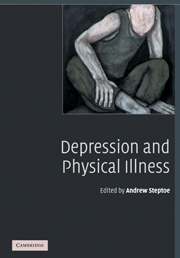Book contents
- Frontmatter
- Contents
- List of contributors
- Preface
- Part 1 Introduction to depression and its determinants
- Part 2 Depression and specific health problems
- 3 Depression and the development of coronary heart disease
- 4 Depression and prognosis in cardiac patients
- 5 The management of depression in patients with coronary heart disease
- 6 Depression and physical disability
- 7 Chronic pain and depression: twin burdens of adaptation
- 8 The interrelationship of depression and diabetes
- 9 Depression and chronic fatigue
- 10 Cancer and depression
- 11 Depression and obesity
- Part 3 Biological and behavioural processes
- Part 4 Conclusions
- Index
- References
6 - Depression and physical disability
from Part 2 - Depression and specific health problems
Published online by Cambridge University Press: 17 September 2009
- Frontmatter
- Contents
- List of contributors
- Preface
- Part 1 Introduction to depression and its determinants
- Part 2 Depression and specific health problems
- 3 Depression and the development of coronary heart disease
- 4 Depression and prognosis in cardiac patients
- 5 The management of depression in patients with coronary heart disease
- 6 Depression and physical disability
- 7 Chronic pain and depression: twin burdens of adaptation
- 8 The interrelationship of depression and diabetes
- 9 Depression and chronic fatigue
- 10 Cancer and depression
- 11 Depression and obesity
- Part 3 Biological and behavioural processes
- Part 4 Conclusions
- Index
- References
Summary
This chapter describes the link between depression and disability. Disability can be defined as a restriction in or lack of ability to perform an activity because of impairment. These activities can include interpersonal relationships, work and school activities and physical activities; the latter is defined as ‘physical disability’. In this chapter, the main focus is on physical disability, since this is the type of disability that has often been examined in relation to depression, especially in old age. However, when appropriate the chapter also elaborates on other types of disability.
The first section of this chapter describes the concept of disability in more detail. The next section provides an overview of research that examines the link between depression and disability. It then goes on to discuss underlying mechanisms that could explain the link between depression and disability. Subsequently, results of intervention studies that try to break the link between depression and disability are described. The chapter ends with some concluding remarks.
Disability: a functional indicator of physical health
Various chapters of this book demonstrate that the importance of chronic conditions for mental health is undisputed. These chapters show that conditions such as cardiovascular disease, diabetes, cancer and chronic fatigue are included among the strongest risk factors for depression, and that the presence of depression influences the course and management of these chronic illnesses. Especially in old age, individuals often have multiple chronic conditions, which may vary in their severity.
Keywords
- Type
- Chapter
- Information
- Depression and Physical Illness , pp. 125 - 144Publisher: Cambridge University PressPrint publication year: 2006

